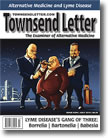Page 1, 2, 3, 4
Proposed 2015 Treatment Options
Lesson one is that all treatments should be started at a low dose and increased to make sure that no one is made to feel discomfort by the dose of the medication or herb. Treatments tend to make people feel better and then make them slightly uncomfortable. Most can tolerate an increase after days or a month. No single recipe exists. The patient and physician need to talk.
Malaria medications should be examined but not blindly added. I do not find any evidence that doxycycline, minocycline, clarithromycin, azithromycin, or sulfamethoxazole/trimethoprim (Bactrim) kills Babesia. I think that the side effects of clindamycin and quinine usually would not make them a first-line treatment.
Of the treatments that do work, we believe that Babesiais so dangerous and disabling in the long term that at least three direct Babesia killers should be used before someone is considered ready for the end of treatment.
Artemisia or sweet wormwood (Artemisia annua) may prevent a malaria infection by just working in the harvesting and tending of this herb. (See Figure 7 of Artemisia annua.) But to kill Babesia, semisynthetic derivatives are required. Qing Cai Zhang, the expert herbal physician sent to the US at the request of our nation, has discussed Babesia treatments.34 In his artemisia and double-potency Artemisiae-2 products, he uses artesunate, a synthetic modification of sweet wormwood. Please note: this is not wormwood (Artemisia absinthum).
Figure 7: Some Artemisia annua or sweet wormwood plants, which are grown all over the world.

One routine Babesia treatment used by Lyme-literate MDs (LLMDs) and functional medicine healers is artemisinin. I wrote in three texts that this derivative is dated, weak, and not even potent enough to kill malaria.35,36 The inability of artemisinin to kill malaria due to resistance is one of many reasons that top malaria agencies are looking for and using other artemisia derivatives.
Artemether/lumefantrine (Coartem or Riamet) is one medication that is partly an Artemisia derivative. This effective malaria medication is also often an effective Babesia medication, and does not have the "yellow paint" taste of atovaquone. In the US it only comes as a tablet: 20 mg of artemether with 120 mg of the synthetic lumefantrine. In many other nations, a generic is 4 times as potent. It is an appealing, small tablet that is dosed 8 tablets daily for 3 days for the treatment of malaria. That dose is profoundly too high for Babesia. Patients may detect benefit at a dose as low as ¼ to 1 tablet a day. You can determine the upper dose with your physician. I was concerned about the risks of artemether 10 years ago, but after seeing and reading about its safe use in millions, I no longer fear this option.
Atovaquone/Proguanil (Malarone) is a combination of the atovaquone mentioned above (Mepron) in a tablet form combined with proguanil.37 This is primarily the only way for most physicians to prescribe proguanil. One initial issue is that it can cause nausea far in excess of what is tolerable. Therefore, we suggest taking the medication in ¼ or ½ tablet units inside empty gelatin capsules, first inside a 0 and then inside a 00, so that the tablet has a double coating. This will end nausea based on stomach contact. If nausea is still present due to direct stomach contact, the addition of marshmallow root is effective at slowing and protecting an irritated stomach mucosa. Dosing should be started at ¼ to ½ tablets per day on the first two days, and then adjusted based on patient experience and insurance coverage. We believe that this is a good, modest Babesia treatment option.
Synthetic garlic derivatives are not your average garlic extract. If one reads Professor K. Huang and Dr. Zhang, it is clear that synthetic drugs have a massive foundation of research in China and Asia, and these do kill babesia.38 But they also kill everything that a tick or flea might carry. You can carry a garlic smell for 36 hours, and dosing needs to start with a pinch or 1/3 to ½ of an allicin capsule from hepapro.com. It may say "allicin" but it is not mere natural garlic.
Mefloquine (Lariam) does kill Babesia.39 However, in our very precise examination of insomnia, mood, irritability, restlessness, and concentration, I believe that the medication tends to create side effects unrelated to the killing of Babesia. I do not think that in most situations these common problems, minimized by some, warrant using it for Babesia.
Nitazoxanide (Alinia) is a newer medication in the parasite community and in the US; it is approved for diarrhea caused by Giardia and Cryptosporidium parvum in children. The French report effective use against Fasciola, a human parasitic disease.40 Dupouy-Camet usefully makes this statement about the uniqueness of nitazoxanide: "[It is] a well-tolerated anti-parasitic agent with a broad spectrum because it is active on many intestinal protozoa and helminths. It acts in the same metabolic way as the 5-nitro-imidazoles inhibition of the ferredoxine reductase) but without synthesis of free radicals and DNA deterioration of the target cell. It is thus neither teratogenic nor mutagenic."41 However, this drug does exit the intestinal track and has other actions that we believe include effective Babesia killing in some individuals and with some strains.
Essential oils have many compounds that can kill Babesia and also human cells. If anyone is truly interested in using this useful and dangerous class of treatments, please start by reading Tisserand and Young's excellent textbook, Essential Oil Safety: A Guide for Health Care Professionals, 2nd edition.42 If your healer has not read this book, s/he has possibly become out of date. If the person proposing essential oils is not familiar with the book, propose it for your safety. Further, we currently have the best-selling biofilm book in the world, and it discusses many of the most effective antibacterial, antifungal, and antiprotozoal essential oils.43
Herbal options for Babesia were initiated above in our discussion of some of the most common medicines in the world – artemisia or sweet wormwood, artesunate, artemether, and artemisinin. But many other herbs exist that have antimalarial and anti-Babesia properties.
As a starting place, after Huang and Zhang, Buhner's herbs are ones that we also have researched most heavily. We have reviewed all of his textbooks published since 2000. We think that both Buhner's and Zhang's herbs are useful and have credible research and experience. We think that most should never be started at a full dose or tablet on the first day, and that they all tend to have a weaker action than some synthetics – which is actually a very good feature. Why? Almost all practitioners overdo treatments on inflamed tick-infected people. This long-term inflammation caused by tick infections causes autoimmunity, allergies to foods and medicines, and less coping ability and makes some patients "overly sensitive" to any treatment. I am not going to list and comment on each one of the herbs that Buhner publishes in his books. Buy his books or ask your librarian to order them through the interlibrary loan program. If you are interested in artemisia in its natural and synthetic forms, consider our text, found inside both our large 2006 Babesia book or as a smaller textbook only discussing the major artemisia derivatives.44,45
Hyperbaric oxygen therapy (HBOT) has many exceptional benefits, but it does not kill Babesia or any major tick infection. For example, we financed a study for over $100,000 to determine the ability of HBOT to kill Babesia, Lyme, and Bartonella. Participants received 110 to 120 treatments at 2.4 atmospheres for 90 minutes. There was no change in their indirect or direct lab results, or their clinical function.
Infrared sauna treatment is based on both high temperature and infrared waves to kill infections. Babesia is very hard to kill, and most of your 100 miles of blood vessels are out of the range of the rays, and high external temperature is not curative of Babesia. A high internal temperature, such as a fever, is a body response to a pathogen.
Ozone is gaining resurgence in interest due to biofilm resistant infections. In terms of ozone, I would suggest as starting points the research and books of Bocci, Shallenberger, and other healers looking for treatments outside of synthetic pharmaceuticals.46,47 Certification and training societies now exist all over the world. We think that direct injection of ozone into veins is malpractice, but that ozone is a useful option that has extensive research and utility in careful wise hands. It has to be dosed carefully, since it is common that individuals kill more of an infection than intended, which causes profound inflammation and discomfort. Ozone is used many ways in industry and health.48-53 It is also an effective killer of microorganisms in pools. One common route to use ozone as a therapeutic agent is to remove blood, add an anticlotting agent, and return the treated blood to the body. This is not a cure, but our observations over 20 years show that it delays Babesia relapse and is a useful tool to augment treatment. Again, the dose of ozone needs to be low on initial trials.
A Sample of Other Treatment Options
Other common Babesia treatments on the Internet and in functional medicine are Rife machines, very low-dose herbal tinctures, acupuncture, intravenous immunoglobulin (IVIG), homeopathy, and energy medicine. Due to space limitations, we will only mention that we are very aware of these modalities, and that some patients and healers report that they work for Babesia. We have inherited patients who were using these options, and their reports and laboratory findings are worthy of further examination. We appreciate that some people report that they believe these treatments are reliable and even curative.
In conclusion, Babesia is a very serious infection with poor to fair sensitivity of laboratory testing, and effective treatments need to be tailored to each patient – mill medicine and simplistic "protocols" lead to poor 5- to 10-year outcomes. Finally, all the comments made in this article are only to be considered with the licensed counsel of your local healing professional. Nothing expressed is to be considered the standard of medical care in the US.
Page 1, 2, 3, 4
|
![]()
![]()
![]()





